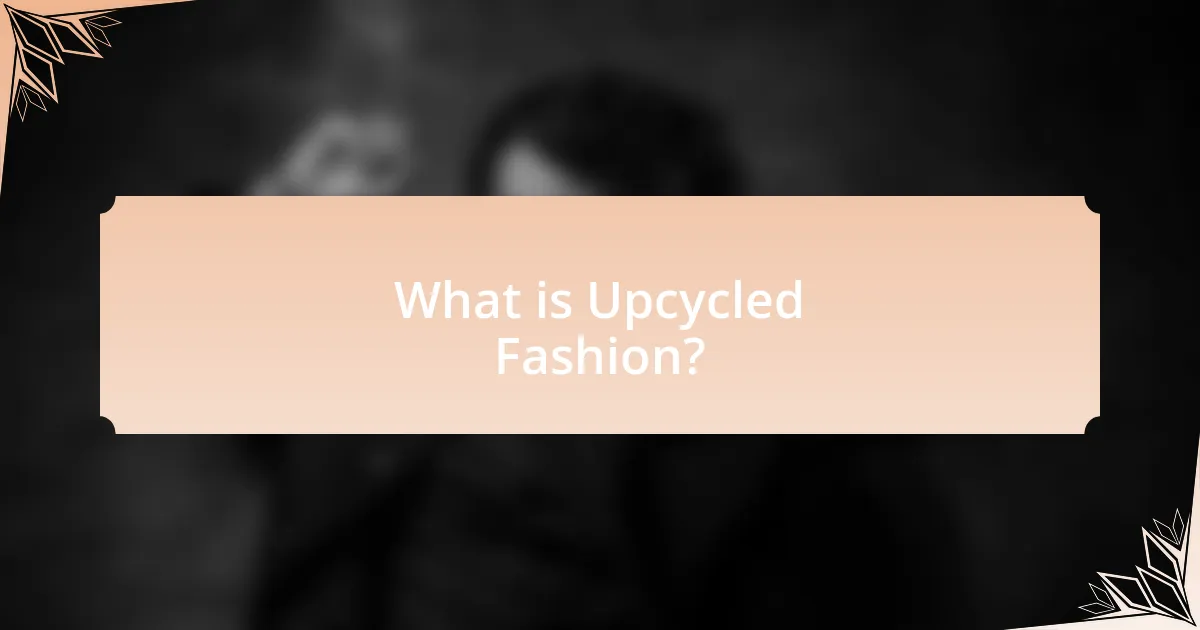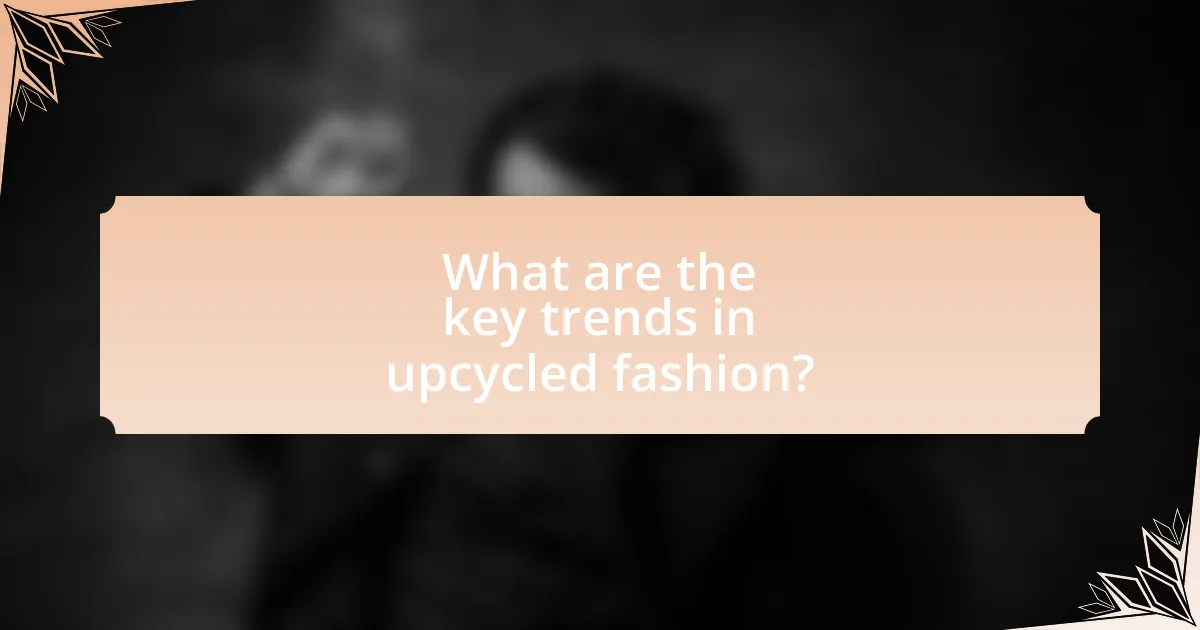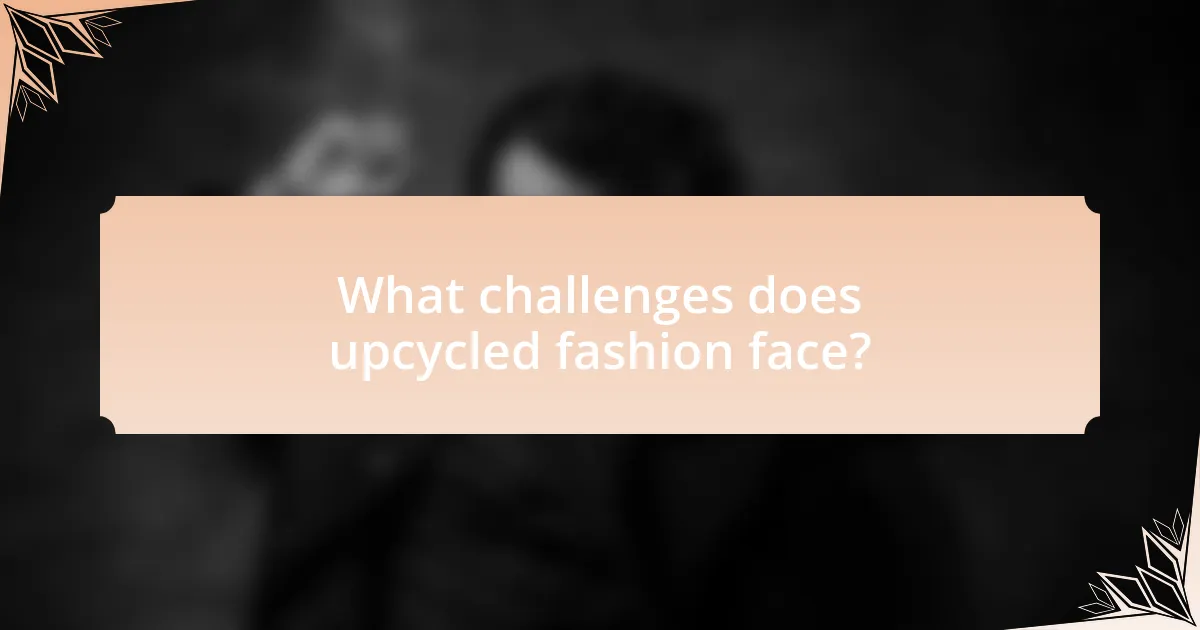Upcycled fashion is the practice of repurposing discarded materials and garments into new clothing and accessories, promoting sustainability and reducing waste in the fashion industry. This article explores the differences between upcycled and traditional fashion, the materials commonly used, and the innovative techniques employed by designers. It also examines the growing popularity of upcycled fashion driven by consumer awareness, the environmental benefits it provides, and the challenges it faces, including misconceptions and logistical issues. Additionally, the article highlights key trends, leading brands, and practical steps consumers can take to support this movement, ultimately emphasizing the importance of upcycling in fostering a more sustainable fashion industry.

What is Upcycled Fashion?
Upcycled fashion is the practice of repurposing discarded materials or garments into new clothing or accessories, thereby reducing waste and promoting sustainability. This approach not only minimizes the environmental impact of the fashion industry, which is responsible for significant pollution and resource depletion, but also encourages creativity and individuality in design. According to a report by the Ellen MacArthur Foundation, the fashion industry generates over 92 million tons of waste annually, highlighting the importance of upcycling as a viable solution to combat this issue.
How does upcycled fashion differ from traditional fashion?
Upcycled fashion differs from traditional fashion primarily in its use of pre-existing materials to create new garments, whereas traditional fashion typically relies on new textiles and resources. Upcycled fashion focuses on sustainability by repurposing discarded items, reducing waste, and minimizing environmental impact, while traditional fashion often contributes to resource depletion and pollution through mass production. For instance, upcycled fashion can involve transforming old clothing or fabric scraps into unique pieces, which contrasts with the conventional approach of sourcing fresh materials for each new collection. This shift towards upcycling is supported by the growing awareness of environmental issues in the fashion industry, highlighting the need for more sustainable practices.
What materials are commonly used in upcycled fashion?
Common materials used in upcycled fashion include discarded textiles, vintage clothing, and surplus fabrics. These materials are repurposed to create new garments, reducing waste and promoting sustainability. For instance, according to a report by the Ellen MacArthur Foundation, the fashion industry generates over 92 million tons of waste annually, highlighting the importance of utilizing existing materials to mitigate environmental impact. Additionally, upcycled fashion often incorporates materials like denim, leather, and even plastic bottles, showcasing creativity while addressing the issue of textile waste.
How is the process of upcycling garments executed?
The process of upcycling garments is executed by creatively transforming discarded clothing into new, functional items. This involves several steps: first, selecting garments that are no longer worn or damaged; second, assessing their potential for redesign or repurposing; third, deconstructing the selected items to salvage usable materials; and finally, reconstructing these materials into new pieces, which may include altering shapes, adding embellishments, or combining multiple garments. Upcycling not only reduces textile waste but also promotes sustainability in fashion by extending the lifecycle of materials, as evidenced by the fact that the fashion industry contributes to 92 million tons of waste annually, highlighting the importance of innovative solutions like upcycling.
Why is upcycled fashion gaining popularity?
Upcycled fashion is gaining popularity due to increasing consumer awareness of environmental issues and the desire for sustainable alternatives to fast fashion. As consumers become more conscious of the negative impacts of textile waste, they are turning to upcycled clothing as a way to reduce their carbon footprint. According to a report by the Ellen MacArthur Foundation, the fashion industry is responsible for 10% of global carbon emissions, prompting a shift towards more sustainable practices. Additionally, upcycled fashion offers unique, one-of-a-kind pieces that appeal to individuals seeking individuality in their wardrobe, further driving its popularity.
What environmental benefits does upcycled fashion provide?
Upcycled fashion significantly reduces environmental waste by repurposing discarded materials into new garments. This process diverts textiles from landfills, where they would otherwise contribute to pollution and greenhouse gas emissions. According to the Environmental Protection Agency, in 2018, approximately 11.3 million tons of textile waste were generated in the United States alone, highlighting the urgent need for sustainable practices. Additionally, upcycling minimizes the demand for new raw materials, thereby conserving resources such as water and energy that are typically required for traditional garment production. By transforming waste into wearable art, upcycled fashion not only promotes sustainability but also encourages a circular economy, where materials are reused rather than disposed of.
How does upcycled fashion contribute to sustainability in the fashion industry?
Upcycled fashion contributes to sustainability in the fashion industry by reducing waste and minimizing the demand for new resources. This practice involves repurposing discarded materials into new garments, which helps divert textiles from landfills; according to the Environmental Protection Agency, in 2018, approximately 11.3 million tons of textile waste were generated in the U.S. alone. By transforming these materials, upcycled fashion not only conserves resources but also lowers carbon emissions associated with the production of new fabrics, as the fashion industry is responsible for about 10% of global carbon emissions. Thus, upcycled fashion plays a crucial role in promoting a circular economy, where materials are reused and recycled, ultimately fostering a more sustainable industry.

What are the key trends in upcycled fashion?
Key trends in upcycled fashion include the increasing use of sustainable materials, innovative design techniques, and a focus on personalization. Sustainable materials, such as discarded textiles and vintage clothing, are being repurposed to create unique garments, reducing waste and environmental impact. Innovative design techniques, like patchwork and reconstruction, allow designers to transform old items into new fashion statements. Additionally, personalization trends, where consumers seek one-of-a-kind pieces that reflect their individual style, are driving the demand for upcycled fashion. These trends are supported by a growing consumer awareness of environmental issues and a shift towards sustainable consumption practices.
How are designers incorporating upcycled materials into their collections?
Designers are incorporating upcycled materials into their collections by creatively repurposing discarded textiles, plastic waste, and other materials to create new garments and accessories. This practice not only reduces waste but also promotes sustainability in the fashion industry. For instance, brands like Reformation and Patagonia utilize surplus fabrics and post-consumer waste, transforming them into stylish, eco-friendly products. According to a report by the Ellen MacArthur Foundation, the fashion industry could reduce its environmental impact significantly by adopting circular practices, including upcycling, which aligns with the growing consumer demand for sustainable fashion options.
What innovative techniques are being used in upcycled fashion design?
Innovative techniques in upcycled fashion design include the use of digital printing, laser cutting, and patchwork methods. Digital printing allows designers to create unique patterns on reclaimed fabrics, enhancing visual appeal while minimizing waste. Laser cutting enables precise alterations and intricate designs, transforming discarded materials into high-fashion items. Patchwork techniques combine various fabric remnants, showcasing creativity and sustainability. These methods not only reduce textile waste but also promote a circular economy in the fashion industry, aligning with the growing demand for environmentally conscious practices.
Which fashion brands are leading the way in upcycled fashion?
Leading the way in upcycled fashion are brands such as Patagonia, Reformation, and Eileen Fisher. Patagonia has been a pioneer in sustainable practices, utilizing recycled materials and promoting repair and reuse through its Worn Wear program. Reformation focuses on creating stylish clothing from surplus fabrics and vintage garments, emphasizing transparency in its supply chain. Eileen Fisher has implemented a take-back program that encourages customers to return used clothing for recycling or resale, further supporting the circular economy. These brands exemplify the commitment to transforming waste into wearable art through innovative practices and sustainable materials.
What role does consumer awareness play in the rise of upcycled fashion?
Consumer awareness significantly drives the rise of upcycled fashion by increasing demand for sustainable and environmentally friendly products. As consumers become more informed about the negative impacts of fast fashion, such as waste generation and resource depletion, they actively seek alternatives that align with their values. Research indicates that 66% of global consumers are willing to pay more for sustainable brands, highlighting a shift in purchasing behavior towards eco-conscious choices. This heightened awareness not only encourages brands to adopt upcycling practices but also fosters a culture of sustainability, making upcycled fashion more mainstream and accessible.
How are consumers being educated about the benefits of upcycled fashion?
Consumers are being educated about the benefits of upcycled fashion through various channels, including social media campaigns, workshops, and educational content from brands. Social media platforms like Instagram and TikTok showcase upcycled fashion items and share stories about their environmental impact, reaching a wide audience. Workshops hosted by local artisans and fashion schools provide hands-on experiences, teaching consumers how to create their own upcycled pieces. Additionally, brands often publish articles and videos that highlight the sustainability benefits of upcycling, such as reducing waste and conserving resources, which reinforces the positive impact of choosing upcycled fashion.
What impact does social media have on the visibility of upcycled fashion?
Social media significantly enhances the visibility of upcycled fashion by providing a platform for creators to showcase their work to a global audience. This visibility is amplified through user-generated content, hashtags, and influencer partnerships, which collectively increase awareness and engagement with upcycled fashion. For instance, platforms like Instagram and TikTok have seen a surge in posts related to upcycled clothing, with hashtags such as #upcycledfashion garnering millions of views, demonstrating the widespread interest and reach. Additionally, studies indicate that social media marketing can lead to a 30% increase in brand awareness for sustainable fashion brands, highlighting its effectiveness in promoting upcycled fashion initiatives.

What challenges does upcycled fashion face?
Upcycled fashion faces several challenges, including limited consumer awareness, inconsistent quality of materials, and scalability issues. Limited consumer awareness hinders market growth, as many potential buyers are unfamiliar with the benefits and availability of upcycled products. Inconsistent quality arises from the diverse sources of materials, which can lead to variations in durability and aesthetics. Scalability issues occur because upcycled fashion often relies on small-scale production, making it difficult to meet larger market demands while maintaining sustainable practices. These challenges collectively impact the industry’s ability to compete with fast fashion and achieve widespread acceptance.
What are the common misconceptions about upcycled fashion?
Common misconceptions about upcycled fashion include the belief that it is low-quality or unattractive. Many people assume that upcycled garments are merely second-hand items or poorly made, but in reality, upcycled fashion often features unique designs and high craftsmanship. For instance, designers like Reformation and Eileen Fisher have successfully integrated upcycled materials into their collections, demonstrating that upcycled fashion can be both stylish and sustainable. Another misconception is that upcycled fashion is only for environmentally conscious consumers; however, it appeals to a broader audience seeking individuality and creativity in their wardrobe.
How do quality and durability concerns affect consumer perceptions?
Quality and durability concerns significantly influence consumer perceptions by shaping their trust and willingness to purchase products. When consumers perceive a product as high-quality and durable, they are more likely to view it as a worthwhile investment, leading to increased satisfaction and loyalty. Conversely, if consumers doubt the quality or durability of a product, they may hesitate to buy it, fearing it will not meet their expectations or last over time. Research indicates that 62% of consumers consider durability a key factor in their purchasing decisions, highlighting its importance in shaping perceptions and driving sales.
What logistical challenges do designers encounter when sourcing materials?
Designers encounter several logistical challenges when sourcing materials for upcycled fashion, primarily including inconsistent availability, quality variability, and transportation issues. Inconsistent availability arises because upcycled materials often depend on waste streams that can fluctuate, making it difficult for designers to predict what materials will be accessible at any given time. Quality variability is another challenge, as the condition of reclaimed materials can differ significantly, impacting the final product’s durability and aesthetic. Transportation issues also complicate sourcing, as designers may need to coordinate the collection of materials from multiple locations, which can lead to increased costs and delays. These challenges highlight the complexities involved in sourcing materials for sustainable fashion initiatives.
How can the fashion industry overcome barriers to upcycled fashion?
The fashion industry can overcome barriers to upcycled fashion by enhancing consumer awareness and improving supply chain logistics. Increased consumer education about the environmental benefits of upcycled fashion can drive demand, as studies show that 66% of consumers are willing to pay more for sustainable products. Additionally, streamlining the supply chain for sourcing materials can reduce costs and improve efficiency, making upcycled fashion more accessible. For instance, partnerships with local organizations can facilitate the collection of discarded textiles, thereby creating a more sustainable and economically viable model for upcycled fashion.
What strategies can brands implement to promote upcycled fashion?
Brands can promote upcycled fashion by leveraging storytelling, engaging in community collaborations, and utilizing social media marketing. Storytelling allows brands to connect emotionally with consumers by sharing the journey of upcycled materials, highlighting the environmental impact and craftsmanship involved. Collaborating with local artists or organizations can enhance brand visibility and authenticity, as these partnerships often resonate with consumers who value sustainability. Social media marketing, particularly through visually-driven platforms like Instagram, can showcase the unique designs and creative processes behind upcycled fashion, attracting a wider audience. According to a 2021 survey by McKinsey, 67% of consumers consider sustainability when making fashion purchases, indicating that effective promotion strategies can significantly influence consumer behavior.
How can collaborations enhance the upcycled fashion movement?
Collaborations can enhance the upcycled fashion movement by combining resources, expertise, and creativity from different stakeholders, leading to innovative designs and broader market reach. For instance, partnerships between fashion brands and local artisans can result in unique products that highlight cultural heritage while promoting sustainability. Additionally, collaborations with environmental organizations can raise awareness about waste reduction and the importance of upcycling, thereby attracting a larger audience. Research indicates that collaborative projects in fashion can increase consumer engagement and drive sales, as seen in initiatives like the “Fashion for Good” program, which fosters partnerships to promote sustainable practices in the industry.
What practical steps can consumers take to support upcycled fashion?
Consumers can support upcycled fashion by purchasing items from brands that specialize in upcycling, thereby directly contributing to the reduction of textile waste. By choosing to buy from these brands, consumers help create a market demand for sustainable practices, which encourages more companies to adopt upcycling methods. Additionally, consumers can participate in clothing swaps or upcycling workshops, which promote the reuse of materials and foster community engagement around sustainable fashion. According to a report by the Ellen MacArthur Foundation, the fashion industry could reduce its environmental impact significantly by embracing circular practices like upcycling, highlighting the importance of consumer involvement in this movement.
How can individuals incorporate upcycled pieces into their wardrobes?
Individuals can incorporate upcycled pieces into their wardrobes by selecting garments that have been creatively transformed from discarded materials. This can include items like denim jackets made from old jeans or bags crafted from repurposed fabric. Upcycled fashion not only promotes sustainability but also offers unique, one-of-a-kind pieces that reflect personal style. According to a report by the Ellen MacArthur Foundation, the fashion industry is responsible for significant waste, and upcycling helps mitigate this by extending the life cycle of materials. By choosing upcycled items, individuals contribute to reducing textile waste while enhancing their wardrobe with distinctive fashion choices.
What resources are available for finding upcycled fashion brands?
Online directories and platforms such as Upcycle That, The Good Trade, and Etsy are valuable resources for finding upcycled fashion brands. These platforms curate lists of brands that specialize in upcycled materials, providing consumers with easy access to sustainable fashion options. For instance, Upcycle That features a comprehensive directory of upcycled products and brands, while The Good Trade emphasizes ethical and sustainable fashion choices, including upcycled items. Etsy also allows users to search specifically for upcycled fashion, connecting them with independent sellers who focus on repurposing materials.